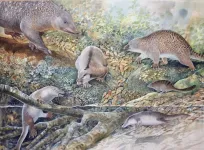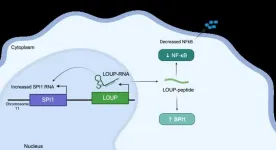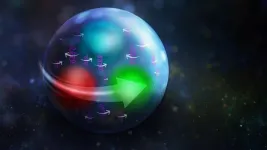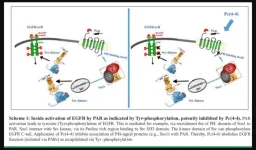(Press-News.org) Artificial Intelligence (AI) technology could offer companionship to lonely people amid an international epidemic of loneliness, says a robotics expert.
Tony Prescott, a professor of cognitive robotics at the University of Sheffield, argues in his new book The Psychology of Artificial Intelligence that ‘relationships with AIs could support people’ with forms of social interaction..
Loneliness has been found to seriously impair human health, and Professor Prescott makes a case that advances in AI technology could offer a partial solution.
He argues that people can spiral into loneliness, becoming increasingly disconnected as their confidence plummets, and that AI might help people to ‘break the cycle’ by giving them a way to practice and improve their social skills.
The impact of loneliness
Loneliness – or social disconnection – is more harmful to human health than obesity, according to a 2023 report. It can increase the risk of premature death by 26% and is associated with a greater risk of cardiovascular disease, dementia, stroke, depression and anxiety. The extent of the problem is striking: in the UK 3.8 million people are experiencing chronic loneliness. A Harvard study in the US found that 36% of US adults – and 61% of young adults - experience serious loneliness.
Professor Prescott says: “In an age when many people describe their lives as lonely, there may be value in having AI companionship as a form of reciprocal social interaction that is stimulating and personalized. Human loneliness is often characterised by a downward spiral in which isolation leads to lower self-esteem which discourages further interaction with people.
“There may be ways in which AI companionship could help break this cycle by scaffolding feelings of self-worth and helping maintain or improve social skills. If so, relationships with AIs could support people to find companionship with both human and artificial others.”
He does suggest this is not without risk, however, as it could be ‘designed to encourage users to interact for longer and longer periods and to keep them coming back’, and suggests regulation may be needed.
AI and the human brain
Prescott is a leading expert on the relationship between the human brain and AI, combining expertise in robotics and AI with psychology and philosophy. He contributes to the scientific understanding of the human condition by researching the re-creation of perception, memory, and emotion in synthetic entities.
As well as researching and teaching cognitive robotics at the University of Sheffield, Prescott is also the co-founder of Sheffield Robotics, which is a hub for robotics research.
In The Psychology of Artificial Intelligence, Prescott explores the nature of the human mind and its cognitive processes and compares and contrasts this with the way AI is developing.
The book explores questions including:
Are computers really like brains?
Will AI surpass humans?
Does AI have the ability to be creative?
Would giving AI a robotic body enable it to create new types of intelligence?
Could AI help us tackle climate change?
And could humans ‘piggyback’ on AI to extend their own intelligence?
He concludes: “As psychology and AI proceed, this partnership should unlock further insights into both natural and artificial intelligence. This could help answer some key questions about what it means to be human and for humans to live alongside AI.”
END
Artificial Intelligence could help cure loneliness, says expert
UNDER EMBARGO UNTIL 00.01 BST on 27 May 2024
2024-05-27
ELSE PRESS RELEASES FROM THIS DATE:
Echidnapus identified from an ‘Age of Monotremes’
2024-05-26
Published today in the Alcheringa: An Australasian Journal of Palaeontology, evidence of an ‘Age of Monotremes’ has been unearthed by a team of Australian scientists at the Australian Museum (AM), Museums Victoria and Australian Opal Centre.
The findings were led by two renowned mammalogists, Honorary Associate of the Australian Museum, Professor Tim Flannery; and Professor Kris Helgen, Chief Scientist and Director of the Australian Museum Research Institute (AMRI).
Found in the Lightning Ridge opal fields, NSW, the opalised jaws ...
Semaglutide may protect kidney function in individuals with overweight or obesity and cardiovascular disease
2024-05-25
The SELECT Trial has revealed the potential of semaglutide, a glucagon-like peptide-1 (GLP-1) receptor agonist, in combating kidney function decline among individuals with overweight or obesity and established cardiovascular disease but without diabetes.1
Unveiling the results today at the 61st ERA Congress, researchers presented the impressive secondary analysis from the SELECT (Semaglutide Effects on Heart Disease and Stroke in Patients with Overweight or Obesity) trial, a randomised trial comprising a participant pool of 17,604 individuals.
Experts believe the study’s results offer hope for those affected by obesity, a condition known ...
New technique detects novel biomarkers for kidney diseases with nephrotic syndrome
2024-05-25
A groundbreaking study, presented today at the 61st ERA Congress, has uncovered a significant breakthrough in the diagnosis and monitoring of kidney diseases associated with nephrotic syndrome.1
Using a hybrid technique, researchers identified anti-nephrin autoantibodies as a reliable biomarker for tracking disease progression, opening new avenues for personalised treatment approaches.
Nephrotic syndrome, characterised by elevated protein levels in the urine, is linked to kidney diseases such as minimal change disease (MCD), primary focal segmental glomerulosclerosis (FSGS), and membranous nephropathy (MN). The primary cause behind nephrotic syndrome is damage to podocytes, the ...
Political elites take advantage of anti-partisan protests to disrupt politics
2024-05-24
Protest movements that reject political parties have an unintended consequence, according to new research from the University of Notre Dame: They empower savvy politicians who channel them to shake up the status quo.
The findings provide a framework for understanding recent global political realignments and offer lessons for activists who want to make a meaningful impact. They are particularly relevant in an era when mass protests have become an increasingly common tool to voice dissent with powerful institutions and draw attention to overlooked issues ranging from climate and conflict ...
Tiny target discovered on RNA to short-circuit inflammation, UC Santa Cruz researchers find
2024-05-24
UC Santa Cruz researchers have discovered a peptide in human RNA that regulates inflammation and may provide a new path for treating diseases such as arthritis and lupus. The team used a screening process based on the powerful gene-editing tool CRISPR to shed light on one of the biggest mysteries about our RNA–the molecule responsible for carrying out genetic information contained in our DNA.
This peptide originates from within a long non-coding RNA (lncRNA) called LOUP. According to the researchers, ...
Charge your laptop in a minute? Supercapacitors can help; new research offers clues
2024-05-24
Imagine if your dead laptop or phone could charge in a minute or if an electric car could be fully powered in 10 minutes.
While not possible yet, new research by a team of CU Boulder scientists could potentially lead to such advances.
Published today in the Proceedings of the National Academy of Sciences, researchers in Ankur Gupta’s lab discovered how tiny charged particles, called ions, move within a complex network of minuscule pores. The breakthrough could lead to the development of more efficient energy storage devices, such as supercapacitors, said Gupta, an assistant professor of chemical and biological engineering.
“Given the critical role ...
Scientists discover CO2 and CO ices in outskirts of solar system
2024-05-24
ORLANDO, May 24, 2024 – For the first time, carbon dioxide and carbon monoxide ices have been observed in the far reaches of our solar system on trans-Neptunian objects (TNOs).
A research team, led by planetary scientists Mário Nascimento De Prá and Noemí Pinilla-Alonso from the University of Central Florida’s Florida Space Institute (FSI), made the findings by using the infrared spectral capabilities of the James Webb Space Telescope (JWST) to analyze the chemical composition of 59 trans-Neptunian objects and Centaurs.
The pioneering study, published ...
Theory and experiment combine to shine a new light on proton spin
2024-05-24
NEWPORT NEWS, VA – Nuclear physicists have long been working to reveal how the proton gets its spin. Now, a new method that combines experimental data with state-of-the-art calculations has revealed a more detailed picture of spin contributions from the very glue that holds protons together. It also paves the way toward imaging the proton’s 3D structure.
The work was led by Joseph Karpie, a postdoctoral associate in the Center for Theoretical and Computational Physics (Theory Center) at the U.S. Department of Energy's Thomas Jefferson National Accelerator Facility.
He said that this decades-old mystery began with measurements of the sources of the proton’s spin in ...
PKMYT1, a potential ‘Achilles heel’ of treatment resistant ER+ breast cancers with the poorest prognosis
2024-05-24
Up to 80% of breast cancer deaths occur in patients with tumors that express estrogen receptor-alpha. Although these estrogen receptor-positive (ER+) breast cancers often initially respond to standard treatment that combines endocrine therapies with CDK4/6 inhibitors, drug resistance often develops leading to lethal metastatic disease that spreads from the breast and does not respond to available treatments.
Looking to identify new vulnerabilities in this type of cancer that could lead to improved therapies, ...
PH-binding motifs as a platform for drug design: Lessons from protease-activated receptors (PARs)
2024-05-24
“We have identified binding motifs within the C-tails of PAR1,2&4, indispensable for cancer growth and development.”
BUFFALO, NY- May 24, 2024 – A new editorial paper was published in Oncoscience (Volume 11) on April 25, 2024, entitled, “PH-binding motifs as a platform for drug design: Lessons from protease-activated receptors; PARs.”
While targeted cancer therapy is greatly dependent on specific oncogenic pathways or conferred by genetic alterations, it remains yet challenging and somewhat disappointing. The high level of failure relies ...
LAST 30 PRESS RELEASES:
Heart-brain connection: international study reveals the role of the vagus nerve in keeping the heart young
Researchers identify Rb1 as a predictive biomarker for a new therapeutic strategy in some breast cancers
Survey reveals ethical gaps slowing AI adoption in pediatric surgery
Stimulant ADHD medications work differently than thought
AI overestimates how smart people are, according to HSE economists
HSE researchers create genome-wide map of quadruplexes
Scientists boost cell "powerhouses" to burn more calories
Automatic label checking: The missing step in making reliable medical AI
Low daily alcohol intake linked to 50% heightened mouth cancer risk in India
American Meteorological Society announces Rick Spinrad as 2026 President-Elect
Biomass-based carbon capture spotlighted in newly released global climate webinar recording
Illuminating invisible nano pollutants: advanced bioimaging tracks the full journey of emerging nanoscale contaminants in living systems
How does age affect recovery from spinal cord injury?
Novel AI tool offers prognosis for patients with head and neck cancer
Fathers’ microplastic exposure tied to their children’s metabolic problems
Research validates laboratory model for studying high-grade serous ovarian cancer
SIR 2026 delivers transformative breakthroughs in minimally invasive medicine to improve patient care
Stem Cell Reports most downloaded papers of 2025 highlight the breadth and impact of stem cell research
Oxford-led study estimates NHS spends around 3% of its primary and secondary care budget on the health impacts of heat and cold in England
A researcher’s long quest leads to a smart composite breakthrough
Urban wild bees act as “microbial sensors” of city health.
New study finds where you live affects recovery after a hip fracture
Forecasting the impact of fully automated vehicle adoption on US road traffic injuries
Alcohol-related hospitalizations from 2016 to 2022
Semaglutide and hospitalizations in patients with obesity and established cardiovascular disease
Researchers ‘listen in’ to embryo-mother interactions during implantation using a culture system replicating the womb lining
How changing your diet could help save the world
How to make AI truly scalable and reliable for real-time traffic assignment?
Beyond fragmented markets: A new framework for efficient and stable ride-pooling
Can shape priors make road perception more reliable for autonomous driving?
[Press-News.org] Artificial Intelligence could help cure loneliness, says expertUNDER EMBARGO UNTIL 00.01 BST on 27 May 2024




